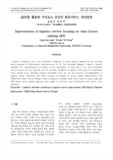

PARTNER
검증된 파트너 제휴사 자료
QFD를 활용한 가치요소 중심의 물류서비스 개선방안
방대한 850만건의 자료 중 주제별로 만들수 있는 최적의 산출물을 해피 캠퍼스에서 체험 하세요 전문가의 지식과 인사이트를 활용하여 쉽고 폭넓게 이해하고 적용할수 있는 기회를 놓치지 마세요
11 페이지
최초등록일 2023.04.05
최종저작일
2017.12

-
 * 본 문서는 배포용으로 복사 및 편집이 불가합니다.
* 본 문서는 배포용으로 복사 및 편집이 불가합니다.
미리보기
서지정보
· 발행기관 : 대한안전경영과학회
· 수록지 정보 : 대한안전경영과학회지 / 19권 / 4호
· 저자명 : 정용석, 강경식
목차
Abstract
1 서론
2. 선행연구
2.1 물류 서비스품질의 개념
2.2 Kano모델에 대한 개념
2.3 QFD(품질기능전개)
3. VBSD(가치기반 서비스 설계) 모델
3.1 고객가치지수(CVI) 산출
3.2 제공자가치지수(PVI) 산출
4. 사례연구
4.1 Kano모델을 이용한 물류 서비스품질 분류와 가중치 결정
4.2 핵심비용요소(KCF)결정과 제공자비용지수(PCI)산출
4.3 고객가치지수(CVI)와 제공자가치지수(PVI)
4.4 가치전략영역의 구분
5. 결론
6. References영어초록
Logistics companies want to be competitive companies in fierce logistics market and are worrying about securing of differentiated competitiveness for it. The standards judging if logistics industry maintains the competitiveness are based on the satisfaction of users due to the well-established service system that can response not only economic feasibility of logistics costs such as transportation costs, storage costs, unloading charges, information costs, etc. but also diversity and upgradability of logistics needs. Therefore, this study focuses on seeking of service quality improvements with VBSD(Value Based Service Design) model focusing on customer value factors based on Kano model and QFD based service design approach from angles of customer value improvement and service costs reduction.참고자료
· 없음태그
-
자료후기
-
자주묻는질문의 답변을 확인해 주세요

꼭 알아주세요
-
본 학술논문은 (주)코리아스칼라와 각 학회간에 저작권계약이 체결된 것으로 AgentSoft가 제공 하고 있습니다.
본 저작물을 불법적으로 이용시는 법적인 제재가 가해질 수 있습니다. -
해피캠퍼스는 구매자와 판매자 모두가 만족하는 서비스가 되도록 노력하고 있으며, 아래의 4가지 자료환불 조건을 꼭 확인해주시기 바랍니다.
파일오류 중복자료 저작권 없음 설명과 실제 내용 불일치 파일의 다운로드가 제대로 되지 않거나 파일형식에 맞는 프로그램으로 정상 작동하지 않는 경우 다른 자료와 70% 이상 내용이 일치하는 경우 (중복임을 확인할 수 있는 근거 필요함) 인터넷의 다른 사이트, 연구기관, 학교, 서적 등의 자료를 도용한 경우 자료의 설명과 실제 자료의 내용이 일치하지 않는 경우
문서 초안을 생성해주는 EasyAI
